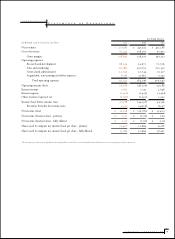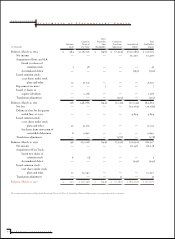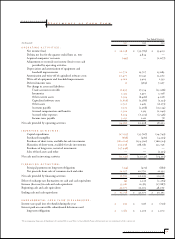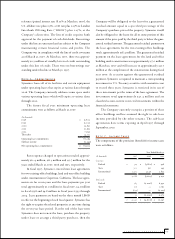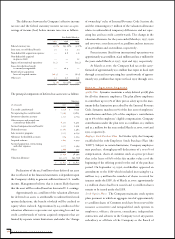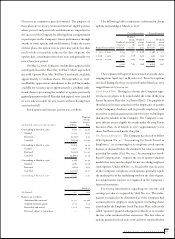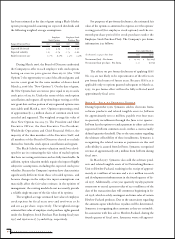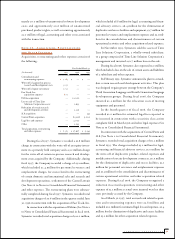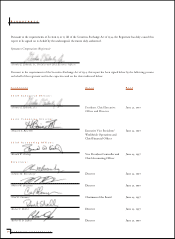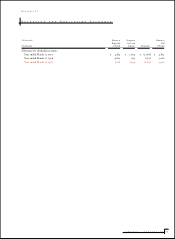Symantec 1997 Annual Report Download - page 51
Download and view the complete annual report
Please find page 51 of the 1997 Symantec annual report below. You can navigate through the pages in the report by either clicking on the pages listed below, or by using the keyword search tool below to find specific information within the annual report.
49
SYMANTEC CORPORATION
Directors or committee may determine). The purpose of
these plans are to attract, retain and motivate eligible persons
whose present and potential contributions are important to
the success of the Company by offering them an opportunity
to participate in the Company’s future performance through
awards of stock options and stock bonuses. Under the terms
of these plans, the option exercise price may not be less than
100% of the fair market value on the date of grant, the
options have a maximum term of ten years and generally vest
over a four-year period.
On May 14, 1996, Symantec stockholders approved the
1996 Equity Incentive Plan (the “96 Plan”) which superseded
the 1988 Option Plan (the “88 Plan”) and made available
approximately 2.7 million shares. On September 25, 1996,
stockholders approved an amendment to the 96 Plan to make
available for issuance up to approximately 1.3 million addi-
tional shares representing the number of options previously
granted pursuant to the 88 Plan that had expired, were canceled
or were unexercisable for any reason without having been
exercised in full.
Stock option and warrant activity was as follows:
Weighted
Average
Number Exercise
(In thousands, except exercise price per share) of Shares Price
Outstanding at March 31, 1994 8,685 $ 12.28
Granted 3,799 19.02
Exercised (1,813) 9.53
Canceled (1,682) 20.20
Outstanding at March 31, 1995 8,989 14.36
Granted 5,990 16.56
Exercised (1,601) 10.40
Canceled (3,660) 22.14
Outstanding at March 31, 1996 9,718 13.43
Granted 2,681 13.90
Exercised (684) 9.89
Canceled (2,673) 14.21
Outstanding at March 31, 1997 9,042 13.61
March 31,
(In thousands) 1997 1996
Balances are as follows:
Authorized but unissued 11,901 10,418
Available for future grants 2,859 700
Exercisable and vested 4,066 3,894
Exercised, subject to repurchase —1
The following tables summarize information about
options outstanding at March 31, 1997:
Outstanding options Exercisable options
Weighted
average Weighted Weighted
Number of contractual average Number of average
shares (in life exercise shares (in exercise
Range of Exercise Prices thousands) (in years) price thousands) price
$ 1.00 - $ 12.50 2,995 7.27 $ 10.18 1,368 $ 9.71
$ 12.56 - $ 14.25 3,104 7.98 13.19 1,415 13.15
$ 14.31 - $ 39.13 2,943 7.64 17.54 1,283 19.42
9,042 7.63 13.61 4,066 13.97
These options will expire if not exercised at specific dates
ranging from April 1997 to March 2007. Prices for options
exercised during the three-year period ended March 31, 1997
ranged from $0.05 to $24.00.
Stock Award Plan During fiscal 1996, the Company regis-
tered 400,000 shares to be issued under the terms of the 1994
Patent Incentive Plan (the “94 Patent Plan”). The purpose of
this plan is to increase awareness of the importance of patents
to the Company’s business and to provide employees with
incentives to pursue patent protection for new technologies
that may be valuable to the Company. The Company’s exec-
utive officers are not eligible for awards under the 1994 Patent
Incentive Plan. As of March 31, 1997, approximately 9,000
shares had been issued under this plan.
Pro Forma Information The Company has elected to follow
APB Opinion No. 25, “Accounting for Stock Issued to
Employees,” in accounting for its employee stock options
because, as discussed below, the alternative fair value accounting
provided for under SFAS No. 123, “Accounting for Stock-
Based Compensation,” requires the use of option valuation
models that were not developed for use in valuing employee
stock options. Under APB No. 25, because the exercise price
of the Company’s employee stock options generally equals
the market price of the underlying stock on the date of grant,
no compensation expense is recognized in the Company’s
financial statements.
Pro forma information regarding net income and
earnings per share is required by SFAS No. 123. This infor-
mation is required to be determined as if the Company had
accounted for its employee stock options (including shares
issued under the Employee Stock Purchase Plan, collectively
called “options”) granted subsequent to March 31, 1995 under
the fair value method of that statement. The fair value of
options granted in fiscal years 1996 and 1997 reported below


